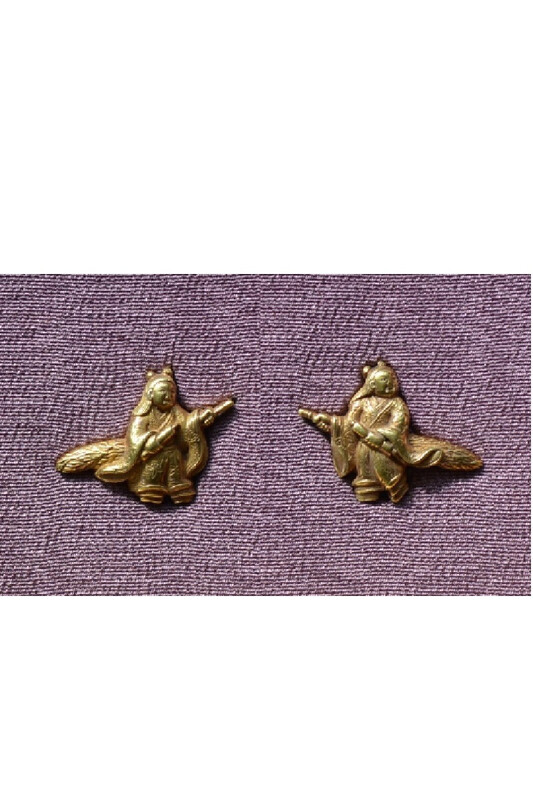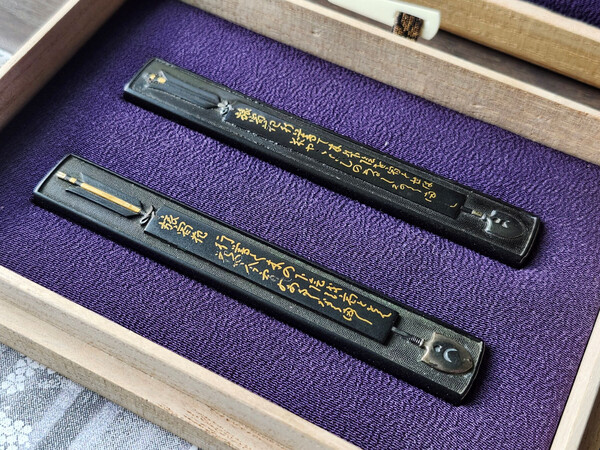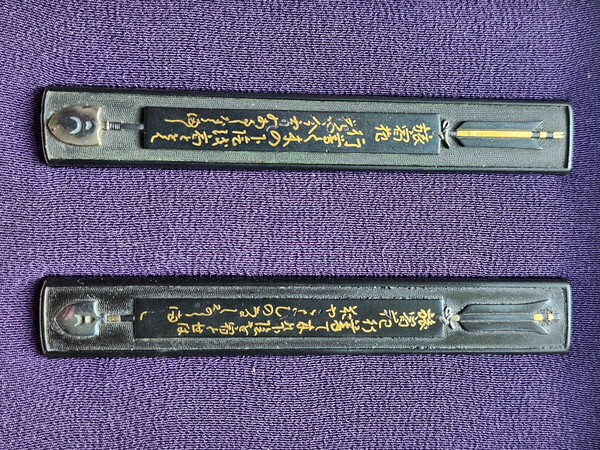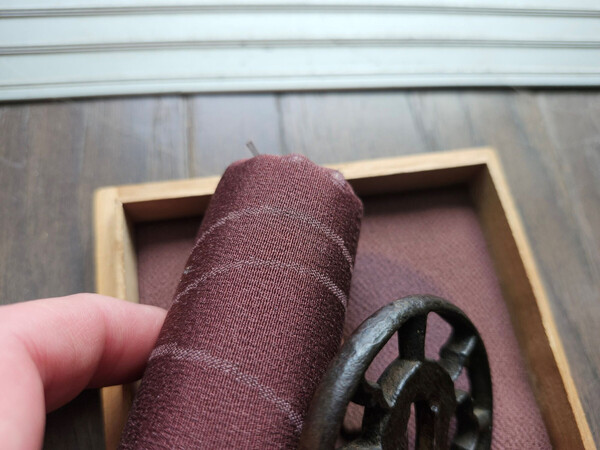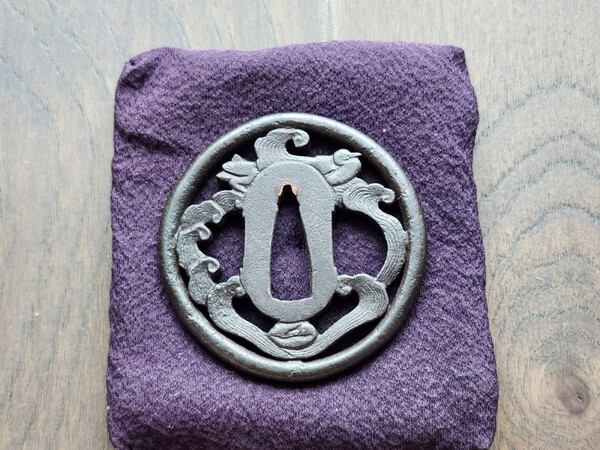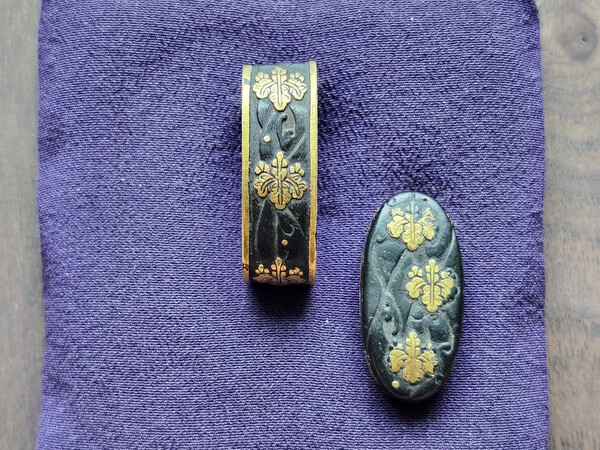-
Posts
4,624 -
Joined
-
Last visited
-
Days Won
23
Content Type
Profiles
Forums
Events
Store
Downloads
Gallery
Everything posted by Curran
-
And some other Kaga works. f/k are Kaga Kinko. Lots of inlay work, and high polish almost as if it were finished with a painter's coat of gloss. The gold menuki are mine. I like the myth behind these two well known characters. The tsuba is not mine. I've sold all my Kaga tsuba, kinda waiting for a really incredible one to come along. I would love one of the multi-butterfly examples. Common to almost all of the Kaga Goto and Kaga Kinko works is a mix of gold, good to great shakudo, and silver. Every one of these pieces has a fair bit of silver either obvious or not so obvious. Some of it is heavily oxidized, and I wouldn't dare to clean it.
-
As Ken said, the Kaga Kinko Taikan is one of the best [Tosogu Porn] books. I have to say I paid a lot more for mine than the one Grey Doffin has on his website. The book is good enough that I thought of buying a second copy. @Charlie C You are correct. Top one is Goto Kenjo and bottom one is Goto Tokujo. Though of the same design, when you get to study them closely (at different angles), you begin to sense patterns in terms of how they 'framed' the design and executed it. One thing that I will share about Goto Kenjo is that he liked to recess his works more. If you study these two kozuka at an angle, you will find the walls of the frame of the kozuka higher and the design set a fraction deeper. I am not sure if I have a picture of this, but will post the best one I can find. It should be attached to this reply.
-
It depends. It can be a hold out "crazy uncle" judge (a bad session or such). @Lewis B you can have all my 7 or 8 Horyu result tags. So far, all have papered the next shinsa where I sent them in [usually the following year]. Many were Middle Weight to Light-Heavyweights. One Horyu is in shinsa_2.0 now and is a heavyweight. When a heavyweight, odds are probably more against a pass. So let us both see. My Horyu were all for fittings.
-
Goto Kenjo Kozuka next to his father's verion of the same theme. I'll take a quick pick of other Kaga Goto examples later today or tomorrow.
- 24 replies
-
- 10
-

-
@Charlie C That is a very interesting topic, punching more deeply into the subject than the average thread here. The Kaga Kinko Taikan was one of the first Taikans I ever bought. As you have laid out, the school is an evolution of imported influences as the Maeda gained strength. It is not like there was one center for metalwork in Kaga. The differences are often technical and usually: (1) based upon the technique, [ex. say nanako work for instance] (2) the metal purity [ex. shakudo], (3) difference in reagants for patinas, etc, (4) framing and execution of designs. Just like unsigned paintings, you can tell a lot from various ways of doing things. [I personally believe this to be very true of Goto Kenjo's Kaga work] I have 3 Tokubetsu Hozon works that are: Kenjo, Kenjo, and Kaga Goto [very sure it is Kenjo too] I also have a nice Hozon f/k that is to Kaga Kinko that is more reflective of the painting style inlay that Ken described. If time allows, I will post pics of some or all this weekend. C.C.C.
-

A Goto school horse menuki with a Fake signature, interesting?
Curran replied to Jack Zacao's topic in Tosogu
You can tell a lot from the central peg and the walls of the backside of a menuki. My first impression is that the back of the menuki doesn't look consistent with Goto Kojo work. I will try to remember to look more later today. It is a nice menuki where I think 'authentic' vs 'gimei' doesn't matter much. My gut says 'Goto' much later in the school, with a spurious mei added later. -
I posted this several years ago, from an article by an Admiral Edwin Layton and Alan Harvie. According to my old notes, it was originally sourced from "Soken Kodogu Yogo lo Meisho no Kaiselsu". Certain types of nanako are associated with certain schools, and I was trying to learn the differences between the nanako of the various Ko-Goto masters up to Goto Tokujo. I think it is one of my projects that fell by the wayside some time ago.
-
What I have is probably in excess of your needs. It is very high end kinko and NBTHK papered. Nor did I particularly want to sell it. Since Owari is one of my two preferred areas of study, I will think to throw you a link when I see anything. I see less and less Owari kinko these days, but sometimes something pops up. My interest is more tsuba.
-
Umetada Duck+Waves tsuba still available. _____________________________________________ Ko-Kinko FK and Kanayama tsuba now sold. --Donation to NMB when transaction is completed.
-
@Sergio M (1) kinko or iron ? (2) papered or non papered ? (3) particular design ?
-

Council
Curran replied to Pritajeni1's topic in Sword Shows, Events, Community News and Legislation Issues
Oh, my face hurts from prolonged smiling. This wasn't an April Fools Day joke, was it? We've had a few, like the Cajun and his National Treasure Beaver Cleaver of a tachi. -
And Donation to NMB if they sell via here. --no Tariffs for USA buyers, since I am in Atlanta. --and I am very good about international shipping. Alright. Peace all, and good night. Curran (aka. "Chris" in his hometown of ATL)
-
Little SALE: Buy 2, take 10% off. Buy 3, take 15% off. Shipping and Customs per your Instructions. (1) Ko-kinko paulownia f/k: $375 (Good set. Better than photos.) (2) Umetada Duck tsuba: $250 (Confuscian Happiness theme.) (3) Kanayama Birds tsuba: $250 (Old illegible writing on back.) --If interested, PM me. -Curran [Chris]
-

BILL Rannow
Curran replied to Stephen's topic in Sword Shows, Events, Community News and Legislation Issues
Chicago show too. -
My first thoughts were Jakushi(?) https://www.facebook.com/photo/?fbid=1246932497437445&set=pb.100063621186223.-2207520000 or Hizen (?) . This to say: Probably from a Kyushu based school.
-
Then travel well. Most here certainly wish you the best. --(Enjoy the kid. We wanted and never got them. My college fencing team captain and Lowell House roommate just wrote me today to say his son graduated HS. ____. )
-
I agree with Brian. Any summarizing might get accused of auditing / censoring.
-
It would be Italy's loss, but maybe you consider Japan a bit more long term? Heaven knows I wish I had tried harder in some of my academic pursuits that would have taken me there in 2021. Personally, I'm stoked by the level of works coming from non Japanese. We see Issei Naruki pieces in many books, and now they get NBTHK Hozon papers. I've owned one or two and seen many Issei Naruki. I'm more impressed by your tsuba.
-
Locking threads should probably be reserved for when things totally go off the rails or get too troglodyte and troll. This thread has gotten very long at 21pgs. My personal opinion is that it has become a time sink hole. I'd appeal to the fellow members here to move onto something else.
-
While good at dating patina and age wear on metals, I am very bad at dating the age of wood. This was proven long ago with my antique sword kake. For years, I thought it was circa 1850. Then looked closer at the bottom and realized it was signed n dated underneath. [ink was a bit hard to see contrasted with the patina]. Turns out it was made 1754. Your saya does remind me of the "pretty one" were I think I was more in love with the shirasaya and the feel of the blade than I was the appearance of the blade. Beautiful tightly arranged yet symetrical growth grain on yours, as on mine. Very good blade, but extra lovely shirasaya and feel to the who elegant thing. Those ivory mekugi rings cannot make the trip in and out of the USA anymore. The last blade I bought was former property of one of the prime-ministers of Japan. It had to have the ivory removed from the shirasaya before export/import.
-
Got off my lazy arse and actually started reading "The Honami Family" by @Markus (Markus Sesko) -published 2012. "Sen no Rikyu was visited by Oda Nobunaga.... (Nobunaga gifts Rikyu with a Masamune)" and "The sword only came in its storage shirasaya, but Rikyu wanted a full mounting..." (top of page 48). Earlier in this thread, I thought the topic was sayagaki on shirasaya . I don't know when that started, but have seen preserved sayagaki on shirasaya from late 1700s or early 1800s, kept nearly as valuable as Honami papers. So, for now, safe to say shirasaya were at least around in Oda Nobunaga and Sen no Rikyu's time. After all these years, a seemingly simple question can throw me. I have no idea when shirasaya came in to use, but it sounds they were common enough in the late Muromachi to early Momoyama period.
-
Sanmei with its retro site, not to different than when it came online 25 years ago. https://www.sanmei.com/enter.html This shop can be very hit or miss. Show you a clunker or two and then show you something very exceptional, possibly produced from the storage space under the couch on which you are sitting. Also, just go to https://www.meihaku.jp/en/ and see what you find from there- Or the Tokugawa Museum (in Nagoya) is always a classic. https://en.wikipedia.org/wiki/Tokugawa_Art_Museum It has been a while since I was there, but discussion with them lead me to one or two local dealers nearly unknown. Got a great tsuba from one of them.



